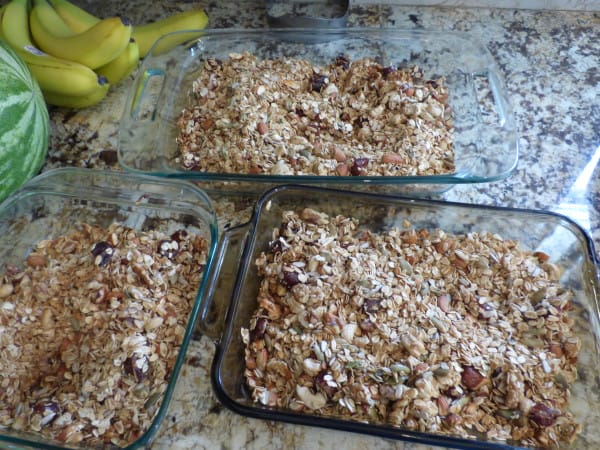Introducing solid foods to your baby is an exciting milestone. It’s a time to explore new tastes and textures and to lay the foundation for healthy eating habits. It can also be a confusing time for some parents. This article discusses introducing first foods for babies, highlighting the importance of nutrient-dense and digestible options, as well as common allergens. This article also covers the signs of readiness for solid foods and two main approaches to introducing foods, baby-led weaning and purees, with a focus on trusting your maternal instincts.
Nutrient Dense Foods For Babies
Under the age of one, the majority of a baby’s calories come from breast milk or formula, as it should be! Most babies start eating solid foods around six months of age (1), at which point babies aren’t consuming a large amount of food yet. For this reason, when it comes to choosing which foods to offer, the focus should be on nutrient-density.
Nutrient-dense foods are concentrated in nutrients per calorie. A great example is beef liver, which is sometimes called ‘nature’s multivitamin’ because it’s jam packed with vitamins and minerals!
 Additional Benefits Of Introducing Food To Babies
Additional Benefits Of Introducing Food To Babies
It’s not only about the nutritional benefits, though! By introducing food to our little ones, they develop important skills, like their pincer grasp, the ability to chew and swallow different textures, and hand-eye coordination. Eating solids also plays a role in normal speech development as it supports the strengthening of the muscles used in speech. Moreover, it’s a sensory experience that exposes babies to a variety of flavors and textures, potentially fostering a more adventurous palate and reducing pickiness in later years. Even if your baby isn’t actually ingesting much of what you offer at first, know that they are getting plenty of benefits just by being included at meal time and exploring what is on their plate.
What Nutrients Should I Focus On For My Baby?
While receiving excellent nutrition from breast milk, breastfed babies require additional nutrients* from food as they approach six months to one year of age. It is not a coincidence that babies start to show signs of food-readiness around six months old when the need for additional nutrient intake arises.
*Infant formula often contains more of the nutrients discussed below. Babies who are exclusively formula fed may have higher levels of these nutrients than their breastfed peers (10). As mentioned above, however, food introduction offers benefits beyond nutrition, and formula fed infants will also benefit from a variety of nutrient dense foods.
Key nutrients for breastfed babies (6 months – 1 year of age):
- Iron: Most newborns have enough iron stored in their bodies for roughly the first 6 months of life. This varies depending on gestational age, the mother’s iron status during pregnancy, and the timing of umbilical cord clamping (2). By age 6 months, however, babies require an external source of iron apart from breast milk, as breast milk contains little iron (2). Sufficient iron intake is crucial for brain development and the prevention of iron-deficiency anemia.
- Vitamin D: Breast milk typically has low levels of vitamin D, which is why many pediatricians recommend vitamin D supplementation for nursing infants or nursing mothers (3). Studies show that maternal vitamin D supplementation with 6400 IU/day supplies breast milk with adequate vitamin D to satisfy the requirement of a nursing infant (4). Sufficient vitamin D intake is essential for bone health and the development of a healthy immune system (5).
- Zinc: While breast milk does provide zinc, zinc levels continue to decrease each month postpartum, and eventually breast milk does not meet the increased demands of older infants (6). Zinc is vital for growth, immune function, and wound healing.
- Vitamin B12: This is primarily a concern if a mother is vegan or vegetarian. B12 is primarily found in animal products, and mothers who are deficient in B12 will produce breast milk that is low in vitamin B12. Vitamin B12 is important for brain development and producing healthy red blood cells (7).
- DHA (Docosahexaenoic Acid): DHA is an omega-3 fatty acid important for brain and eye development. While present in breast milk, levels depend on a mother’s diet (8). Research shows that a vast majority of adults and children in the U.S. do not consume the recommended amount of DHA (9).
A Look At Your Baby’s Digestive System
Babies’ digestive systems are still developing, making them less capable of processing certain types of foods due to their limited enzyme production.
At birth, infants produce very little of the digestive enzyme amylase, which is responsible for digesting carbohydrates. They gradually produce more over time, beginning around 7 or 8 months of age, and by about 19 months toddlers start to produce adult levels of this digestive enzyme (11). Foods high in complex carbohydrates, like cereals, grains, and breads, can be challenging for babies to digest and many little ones do best with limited grains until closer to a year old. This is one reason to delay, or refrain from, introducing baby cereal.
 Enzymes produced by babies include lactase, pepsin, proteolytic enzymes, and hydrochloric acid. Lactase is the enzyme necessary for digesting lactose found in milk. Babies also produce digestive enzymes, like pepsin and proteolytic enzymes (12), as well as digestive juices, such as hydrochloric acid in the stomach (13), that equip them to handle proteins from infancy.
Enzymes produced by babies include lactase, pepsin, proteolytic enzymes, and hydrochloric acid. Lactase is the enzyme necessary for digesting lactose found in milk. Babies also produce digestive enzymes, like pepsin and proteolytic enzymes (12), as well as digestive juices, such as hydrochloric acid in the stomach (13), that equip them to handle proteins from infancy.
Dietary fats require bile and lipase for digestion. Babies start producing bile during the third trimester of pregnancy and continue to increase bile production during their first 3-5 weeks of life (14). Infants are born with lingual lipase and very limited amounts of pancreatic lipase that increases at weaning age (15). This is perfect timing for the digestion of fat containing solid foods! It’s interesting to note that breast milk, which contains plenty of good fats, contains lipase to compensate for the low amounts of pancreatic lipase produced by young infants.
Key First Foods For Babies
Most babies are especially in need of iron, vitamin D, zinc, vitamin B12, and DHA. Since their digestive tracts are equipped to break down protein and fat, we can selectively choose proteins and fats that are rich in these crucial nutrients.
My favorite first foods for babies:
- Egg Yolks: A top choice for introducing iron and vitamin D, egg yolks are not only rich in good fats but also essential nutrients for brain development. They provide choline and other B vitamins important for neurological development and cognitive function.
- Grass-Fed Liver: This is an incredibly nutrient-dense food, especially rich in iron, vitamin B12, and vitamin A. Iron supports healthy blood and brain development, while vitamin B12 is important for nerve function and overall brain health. Opened beef liver capsules are a great way to conveniently add this superfood to your babies meals.
- Avocado: A wonderful source of healthy monounsaturated fats that are essential for a baby’s growth and brain development. Avocados also contain a modest amount of zinc and are a digestible source of nutrients for babies.
- Sardines: These small fish are packed with omega-3 fatty acids, particularly DHA, which is crucial for brain and eye development. They also provide vitamin D and are a good source of calcium for bone development.
- Banana: Bananas contain amylase, the digestive enzyme needed to digest carbohydrates that infants don’t produce in large quantities. In contrast to most grains and cereals, bananas are a good source of carbohydrates for babies because they are easily digestible and most little ones love the taste!
- Cod Liver Oil: Cod liver oil is particularly known for its high levels of omega-3 fatty acids, vitamin D, and vitamin A (16). Sufficient omega-3 fatty acids intake, especially DHA, is vital for brain and eye development (17). Vitamin D, abundant in cod liver oil, is essential for bone health and immune system development and supports the body’s absorption of calcium and phosphorus (18). Cod liver oil can be given in small amounts, starting at four months of age.
Note: When mashing or pureeing foods, adding liquids like breast milk or bone broth will make it easier for babies to chew and digest while adding an extra boost of nutrients. Healthy fats, like grass fed butter and coconut oil, can be added in small amounts as well.
Can My Baby Eat Fermented Foods?
While fermented foods may not come to mind when thinking of baby foods, they are great early food for infants. Historically, they were often among the first foods parents introduced to their babies. Fermented foods are easy to digest as the fermentation process ‘pre-digests’ the food. This is especially useful when babies eat carbohydrates as they produce little of the enzyme needed to digest carbohydrates. Most probiotic foods are nutrient dense and provide good bacteria for a happy, healthy gut!
Offering fermented foods early and frequently can be a way to accustom your child’s palate to their distinct flavor and set the scene for a lifetime of health benefits and enjoyment. A good way to start is to mix a small amount of probiotic food into other food items, like a teaspoon of kefir mixed into a mashed banana or blending some sauerkraut (or sauerkraut juice) into an avocado puree.
Next Steps After Introducing Foods To Baby
Once your baby does well with the foods mentioned above, you may expand to new food options. I encourage parents to choose whole food options and focus on nutrient density while staying away from added sugars.
 Some healthy ‘phase two’ foods to incorporate into your baby’s diet include: beets, carrots, sweet potatoes, cottage cheese, full fat plain yogurt, fruits, and stews. Work with foods that you regularly purchase rather than creating a separate menu for your child. You may find yourself choosing healthier options for yourself, too!
Some healthy ‘phase two’ foods to incorporate into your baby’s diet include: beets, carrots, sweet potatoes, cottage cheese, full fat plain yogurt, fruits, and stews. Work with foods that you regularly purchase rather than creating a separate menu for your child. You may find yourself choosing healthier options for yourself, too!
To learn more about what constitutes a healthy diet for the whole family, read: The Basics Of Anti-Inflammatory Eating For The Whole Family
To learn more about nutrient and calorie dense foods for babies and toddlers, read: Nutrient & Calorie Dense Foods That Help Underweight Kids Thrive
Introducing Potential Allergens
In the past, parents were advised to wait until their baby was at least 12 months old before introducing potential allergens, like eggs, fish, and nuts. However, recent research suggests that introducing allergenic foods like peanuts and eggs earlier in a baby’s diet may reduce the risk of developing food allergies (20). This counterintuitive approach is supported by studies, like the Learning Early About Peanut Allergy (LEAP) trial, which indicates that earlier exposure may lead to tolerance and lower the incidence of allergies later in life (21). Therefore, once your baby shows signs of food readiness, you can start incorporating small amounts of potential allergens into their diet.
It is recommended to wait 3-5 days between introducing new foods to your baby to allow you to observe any potential reactions or digestive issues (19).
If your child has a family history of allergies, severe eczema, or other factors that lead you to suspect they may be susceptible to allergic reactions, consult with your pediatrician on the best way to approach introducing potential allergens.
Want to learn more about different types of food sensitivities? Read: 21 Different Types of Food Sensitivities
Want to learn more about testing for food allergies? Read: Elimination Diet vs Allergy Blood Test: Which Is Best For Assessing Food Sensitivities?
How Will I Know My Baby Is Ready For Solids?
Babies are typically ready to start solids around 6 months of age (19).
Signs of readiness include:
- Ability to sit up with little or no support
- Good head and neck control
- Showing interest in food, such as reaching for food
- Decreased tongue-thrust reflex, allowing an infant to move food to the back of the mouth and swallow
Two Approaches To Food Introduction
Two main approaches for introducing food to babies are Baby-Led Weaning (BLW) and purees. Both have benefits, and neither method is wrong. This is one of the areas where parents need to tune in with their instincts and go with what feels best.
The Puree Approach For Introducing First Foods
The puree approach to baby feeding involves spoon feeding baby pureed foods. Usually, parents begin with smooth purees that they gradually make thicker and chunkier as their baby is able to manage thicker textures.
Benefits of the Puree Approach to Baby Feeding:
- Ease of Introduction: Purees offer a smooth transition from liquid to solid foods. They’re easy to swallow, which is beneficial for younger infants just starting on solids and may calm anxious parents’ fear of choking.
- Controlled Nutrition: With purees, it’s easy to know that your baby is getting a variety of nutrients. Parents can mix different foods and include key nutrients, like iron, zinc, and various vitamins, which may be more challenging to control with finger foods.
- Convenience: Purees can be made in bulk and frozen for convenience, and as you introduce new foods, you can mix up different combinations of nutrients and flavors.
- Allergen Introduction: Purees allow for the gradual introduction of potential allergens in small amounts, which allows for the effective monitoring of any reactions.
The Baby-Led Weaning Approach For Starting Solids
The Baby-Led Weaning (BLW) approach to infant feeding involves offering babies safely prepared portions of family meals and allowing them to explore these foods and self feed as much or as little as they’d like.
Benefits of the Baby-Led Weaning Approach:
- Promotion of Motor Skills and Independence: BLW encourages babies to feed themselves, enhancing fine motor skills, hand-eye coordination, and independence. It involves offering safely prepared ‘chunks’ or ‘sticks’ of food, and allows babies to explore food at their own pace and develop self-regulation in eating.
- Encouraging Exploration and a Diverse Palate: This approach exposes babies to a wide range of textures and flavors, and proponents say this can lead to a more adventurous palate.
- Convenience & Bonding (Family Meals): BLW integrates babies into family meal times, as they can often eat modified versions of what the rest of the family is eating, encouraging social skills and making mealtimes a shared experience.
- Development of Chewing Skills: As BLW involves a variety of textures, it may help in the development of chewing skills, which is beneficial for oral and speech development.
Note: If you choose to follow a Baby-Led Weaning approach, it is important to research how to present food to your baby to prevent choking. A valuable resource for this is Solid Starts.
Combination Feeding: Can I Combine Baby-Led Weaning With Puree Feeding?
Many families find that a combination of both methods works best for them. This hybrid approach allows for the benefits of controlled nutrient-dense meals through purees, while also giving babies the chance to explore and self-feed with finger foods.
How Much Should My Baby Be Eating?
As your baby transitions into the world of solid foods, it’s important to remember that each child’s appetite and eating habits can vary significantly. Below are some guidelines to help you understand how much your baby should be eating.
Before Age 1: Breast Milk or Formula Primary Source
For the first year, breast milk or formula should remain the primary source of nutrition. Until at least 9 months of age, offer your child breast milk or formula first and solid foods second. After 9 months of age, starting with one meal at a time, offer solid foods with a cup of breast milk or formula on the side. Babies need a minimum of 24 ounces of breast milk or formula per day until their first birthday.
Guidelines For Solid Food Intake By Age
- At 6 months, solid food is a complement to breast milk or formula. Start with a few teaspoons of food once per day.
- Around 9 months, gradually increase to 2-3 meals per day.
- By 12 months, many babies are eating 3 meals per day, along with some snacks.
Understanding Your Baby’s Hunger and Fullness Cues When Introducing Solids
Babies will signal when they are hungry and when they are full. Look for cues like excitement and an open mouth when hungry and turning away or losing interest when full. It’s easy to worry that your baby isn’t eating enough, but overfeeding can be an issue as well. Trust your baby to eat the amount they need, and don’t force them to finish a meal if they show signs of being full. Some days, your baby might eat more than usual and on other days less. This fluctuation is normal. Focus on providing a balanced diet over the course of a week rather than stressing about each meal.
A Note On Processed ‘Baby Snacks’ and Empty Calories
In the United States, 73% of our food supply is ‘ultra-processed’ (22). In fact, an entire industry has been created around baby food and snacks, many of which are considered processed or ultra-processed foods.
 There really is no need for a separate grocery aisle for babies, as throughout history, babies ate whole foods along with their families.
There really is no need for a separate grocery aisle for babies, as throughout history, babies ate whole foods along with their families.
Though I believe wholeheartedly in an 80/20 approach, I caution parents against accustoming their young children to processed snacks and treats. The longer you can hold off, the better!
Baby cookies, crackers, fruit purees from concentrate, juices, melts, and puffs are all ‘extra’ and are not needed in your baby’s diet. If you choose to offer these snacks, for example on an airplane ride when you need something exciting to keep your baby entertained, I recommend offering breast milk or formula first, followed by a whole food option, and finally the fun snack.
Should I Worry About Choking When Introducing New Foods To A Baby?
Many parents worry about choking when introducing foods to their baby. This is an understandable fear, and it is worth familiarizing yourself with common choking hazards and the recommended ways in which to prepare different foods if you are following a BLW approach.
Common choking hazards for young children:
- Uncut grapes and cherry tomatoes: Always cut these items in their length, with the idea being that you want to make sure they don’t have a round circumference. A round grape is the perfect shape to block the esophagus.
- Hot dogs and cheese sticks: Much like the grapes and cherry tomatoes, be sure to cut hot dogs and cheese sticks length-wise, so they no longer have a round circumference.
- Nuts and popcorn: These are also common choking hazards for young children. Puree nuts and hold off on popcorn until age 4.
Always pay close attention when your child is eating, and have them sit down to eat their meal. Familiarize yourself with the steps to take, so if your baby does choke you know what to do. Many parents choose to print the steps and keep them in a visible place in the kitchen or dining area.
Help! My Baby Is Constipated After Introducing Solids
Constipation is a common concern of parents when introducing solids to their babies. It is normal for a baby’s stool pattern to change along with their dietary pattern! Hard and dry stools, going more than two days between bowel movements, and straining to pass a stool are signs of constipation and that your baby needs a little support to get things moving. Remember to introduce solids gradually and to stay on top of hydration. Your baby should still be consuming a minimum of 24 oz of breast milk or formula per day until 12 months old.
To learn more about constipation and how to treat it, read: Treating Constipation In Kids & Babies With Integrative Medicine
To learn more about constipation and abdominal massage, read: Abdominal Massage For Infant Colic & Constipation Relief In Toddlers And Kids
Summary
Introducing solid foods is an exciting milestone for parents and little ones! It is not just about filling their bellies but also about nurturing their overall growth and development. Most babies show signs of readiness to begin eating solids, such as sitting up with minimal support, around 6 months of age. It is important to know that breast milk or formula should remain the primary source of nutrition for the first year. Introducing nutrient-dense foods, in conjunction with continued breast or bottle feeding, provides essential vitamins and minerals.
When we look at what makes an ideal food for young infants, it’s important to consider the baby’s developing digestive system and unique nutrient needs. Additional considerations for parents and infants ready to start solids include potential allergen introduction and preferred feeding approach. Remember to watch for your baby’s hunger and fullness cues, gradually increase solid food intake, and minimize or skip processed baby snacks.
References:
- CDC. (2021, August 24). When, What, and How to Introduce Solid Foods. Centers for Disease Control and Prevention. https://www.cdc.gov/nutrition/infantandtoddlernutrition/foods-and-drinks/when-to-introduce-solid-foods.html
- CDC. (2021, September 2). Do infants get enough iron from breast milk? Centers for Disease Control and Prevention. https://www.cdc.gov/breastfeeding/breastfeeding-special-circumstances/diet-and-micronutrients/iron.html
- CDC. (2019, December 14). Vitamin D is needed to support healthy bone development. Centers for Disease Control and Prevention. https://www.cdc.gov/breastfeeding/breastfeeding-special-circumstances/diet-and-micronutrients/vitamin-d.html
- Hollis, B. W., Wagner, C. L., Howard, C. R., Ebeling, M., Shary, J. R., Smith, P. G., Taylor, S. N., Morella, K., Lawrence, R. A., & Hulsey, T. C. (2015). Maternal Versus Infant Vitamin D Supplementation During Lactation: A Randomized Controlled Trial. Pediatrics, 136(4), 625–634. https://doi.org/10.1542/peds.2015-1669
- Vitamin D for Babies, Children & Adolescents. (n.d.). HealthyChildren.org. Retrieved January 17, 2024, from https://www.healthychildren.org/English/healthy-living/nutrition/Pages/vitamin-d-on-the-double.aspx
- Krebs, N. F., Westcott, J. E., Culbertson, D. L., Sian, L., Miller, L. V., & Hambidge, K. M. (2012). Comparison of complementary feeding strategies to meet zinc requirements of older breastfed infants. The American journal of clinical nutrition, 96(1), 30–35. https://doi.org/10.3945/ajcn.112.036046
- CDC. (2018, January 24). Vitamin B12 . Centers for Disease Control and Prevention. https://www.cdc.gov/breastfeeding/breastfeeding-special-circumstances/diet-and-micronutrients/vitamin-b12.html
- Juber, B. A., Jackson, K. H., Johnson, K. B., Harris, W. S., & Baack, M. L. (2017). Breast milk DHA levels may increase after informing women: a community-based cohort study from South Dakota USA. International breastfeeding journal, 12, 7. https://doi.org/10.1186/s13006-016-0099-0
- Papanikolaou, Y., Brooks, J., Reider, C., & Fulgoni, V. L., 3rd (2014). U.S. adults are not meeting recommended levels for fish and omega-3 fatty acid intake: results of an analysis using observational data from NHANES 2003-2008. Nutrition journal, 13, 31. https://doi.org/10.1186/1475-2891-13-31
- Martin, C. R., Ling, P. R., & Blackburn, G. L. (2016). Review of Infant Feeding: Key Features of Breast Milk and Infant Formula. Nutrients, 8(5), 279. https://doi.org/10.3390/nu8050279
- Gillard, B. K., Simbala, J. A., & Goodglick, L. (1983). Reference intervals for amylase isoenzymes in serum and plasma of infants and children. Clinical chemistry, 29(6), 1119–1123.
- Holton, T. A., Vijayakumar, V., Dallas, D. C., Guerrero, A., Borghese, R. A., Lebrilla, C. B., German, J. B., Barile, D., Underwood, M. A., Shields, D. C., & Khaldi, N. (2014). Following the digestion of milk proteins from mother to baby. Journal of proteome research, 13(12), 5777–5783. https://doi.org/10.1021/pr5006907
- Kelly, E. J., & Brownlee, K. G. (1993). When is the fetus first capable of gastric acid, intrinsic factor and gastrin secretion?. Biology of the neonate, 63(3), 153–156. https://doi.org/10.1159/000243925
- Lester R. (1979). Bile acid metabolism in the fetus and newborn. Ciba Foundation symposium, (70), 99–115. https://doi.org/10.1002/9780470720530.ch6
- Miller, R., & Lowe, M. E. (2008). Carboxyl ester lipase from either mother’s milk or the pancreas is required for efficient dietary triglyceride digestion in suckling mice. The Journal of nutrition, 138(5), 927–930. https://doi.org/10.1093/jn/138.5.927
- Ross, C. M. (2005). Fish Oil versus Cod Liver Oil: Is Vitamin D a Reason to Go Back to the Future. The Journal of the American Board of Family Practice, 18(5), 445–446. https://doi.org/10.3122/jabfm.18.5.445-b
- Avenue, 677 H., Boston, & Ma 02115. (2012, September 18). Omega-3 Fatty Acids: An Essential Contribution. The Nutrition Source. https://www.hsph.harvard.edu/nutritionsource/what-should-you-eat/fats-and-cholesterol/types-of-fat/omega-3-fats/
- Harvard. (2012, September 18). Vitamin D. The Nutrition Source. https://www.hsph.harvard.edu/nutritionsource/vitamin-d/
- Centers for Disease Control and Prevention. (2018, December 3). When, What, and How to Introduce Solid Foods . Centers for Disease Control and Prevention. https://www.cdc.gov/nutrition/infantandtoddlernutrition/foods-and-drinks/when-to-introduce-solid-foods.html
- Chin, B., Chan, E. S., & Goldman, R. D. (2014). Early exposure to food and food allergy in children. Canadian family physician Medecin de famille canadien, 60(4), 338–339.
- Learning Early About Peanut Allergy (LEAP) – FoodAllergy.org. (n.d.). Www.foodallergy.org. https://www.foodallergy.org/resources/learning-early-about-peanut-allergy-leap
- Menichetti, G., Babak Ravandi, Dariush Mozaffarian, & Albert‐László Barabási. (2021). Machine Learning Prediction of Food Processing. MedRxiv (Cold Spring Harbor Laboratory). https://doi.org/10.1101/2021.05.22.21257615








2 Comments